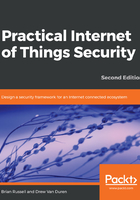
Defining cyber-physical systems
Cyber-Physical Systems (CPSes) are a huge, overlapping subset of the IoT. They fuse a broad range of engineering disciplines, each with a historically well-defined scope that includes the essential theory, lore, application, and relevant subject matter needed by their respective practitioners. These topics include engineering dynamics, fluid dynamics, thermodynamics, control theory, digital design, and many others. So, what is the difference between IoT and CPS? Borrowing from the IEEE, the principal difference is that a CPS—comprising connected sensors, actuators, monitoring and control systems—does not necessarily have to be connected to the internet. A CPS can be isolated from the internet and still achieve its business objective. From a communications perspective, the IoT is comprised of things that, necessarily and by definition, are connected to the internet and, through some aggregation of applications, achieve some business objective:

It is worthwhile to think of the IoT as a super-set of CPSes, as CPSes can be enveloped into the IoT simply by connectivity to the internet. A CPS is generally a rigorously engineered system designed for safety, security, availability, and functionality. Emergent enterprise IoT deployments should take note of the lessons learned through the engineering rigor associated with CPSes. For more information on building resilient CPSes, consult the National Institute of Standards and Technology (NIST) Framework for Cyber Physical Systems (https://s3.amazonaws.com/nist-sgcps/cpspwg/files/pwgglobal/CPS_PWG_Framework_for_Cyber_Physical_Systems_Release_1_0Final.pdf) and its related efforts to the IoT-Enabled Smart Cities Framework and others (https://www.nist.gov/el/cyber-physical-systems).